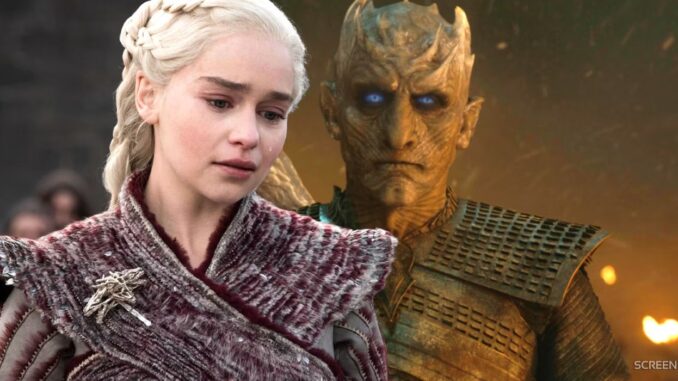
The Winds Of Winter Needs To Fix A Game Of Thrones Plot Hole That Still Bothers Me 5 Years After The Ending
Game of Thrones season 8 made one confusing decision involving the Night King, but George R.R. Martin’s The Winds of Winter can properly explain it.
The Winds of Winter has the chance to put right or explain one confusing part of Game of Thrones season 8. George R.R. Martin’s sixth A Song of Ice and Fire book has been in the works since 2011, the year that both the most recent novel in the series (A Dance with Dragons) was released and Game of Thrones started on HBO. As the wait goes on, the backlash to Game of Thrones’ ending only adds greater pressure to the next installment.
Although The Winds of Winter is taking a long time, it – and the planned seventh book, A Dream of Spring – will hopefully tell the story better than Game of Thrones did. One part of what went wrong with Game of Thrones season 8 was its handling of the White Walkers, as it dealt with the villains in just three episodes and left many mysteries unsolved. Ideally, Martin’s book will fill some gaps, especially regarding one plot hole from season 8, episode 3, “The Long Night,” which saw the Night King survive a blast of dragonfire – a shocking moment that went unexplained.
Why Didn’t Dragonfire Kill The Night King When Valyrian Steel Did?
Game of Thrones season 8 left a big plot hole.
The Night King emerging unscathed from Drogon’s blast of fire in Game of Thrones season 8 made for some memorable imagery, but was also quite confusing. How, exactly, did he survive it? There was no time for the show itself to answer this question as the Battle of Winterfell went on and, eventually, the Night King was killed by Arya Stark. But, really, it doesn’t make any sense.
So if Valyrian steel kills them, then why not fire from a dragon who was born thanks to… blood and fire magic?

The Night King and White Walkers are effectively beings of pure cold and ice (though they were once human), so it’s logical that regular fire doesn’t affect them, as seen at a few points during the show. But dragonfire should be different, because dragons are magical creatures. That’s more obvious given Valyrian steel does kill them, when regular steel does not. This is because how Valyrian steel was made remains mysterious, though it included dragons and some kind of magic, thought to be blood or fire magic. So if Valyrian steel kills them, then why not fire from a dragon who was born thanks to… blood and fire magic?
Dragonglass, or obsidian, killing the White Walkers makes perfect sense, as the series showed this was used to create the Night King. At the time of the first Long Night, however, it’s highly unlikely there’d have been Valyrian steel. This came from Old Valyria, and the rise of the Valyrian freehold, while thousands of years ago (so there’s room for error), is estimated to have been after the Long Night. Either way, it’d be odd for there to have been Valyrian steel, so it’s unclear why this can kill them, and then doubly so that it can, but dragonfire cannot.
One theory offered to explain it is that the Night King was a Targaryen and, as Daenerys explained, fire cannot kill a dragon. There are, however, many problems with this. Daenerys being fireproof was a change from the books, which turned it from a one-off magical event into a character trait, but there’s no evidence other Targaryens are immune to fire. Even if they were, it’d be impossible for the Night King (who did not look like a Targaryen when human) to be one given the timeline of the Long Night far pre-dates Targaryens and other Valyrians coming to Westeros.
Why The Winds Of Winter Will Avoid Game Of Thrones’ Dragonfire Plot Hole
George R.R. Martin’s A Song of Ice and Fire books could explain it.
Game of Thrones mishandled the White Walkers and dragonfire, but it’s unlikely George R.R. Martin will make the same mistake with The Winds of Winter. For starters, the Night King was invented by Game of Thrones, and no such character exists in the books. The Others are more of a mystical force – it’s unclear if their creation by the Children of the Forest will still happen – and so there may not even be a specific moment of one surviving a blast of dragonfire when the second Long Night does eventually happen.
Even if it does, though, it’d be very surprising if Martin allowed such a plot hole to exist. The books allow for far greater detail, and he loves adding to the depth of worldbuilding. He lays out more clearly defined rules, and so it’s not unreasonable to assume he may eventually explain the origin of Valyrian steel or, if dragonfire couldn’t kill the White Walkers, he’d find a way of explaining it.
“This could be by connecting Valyrian steel to Lightbringer, the sword that legend says was wielded by Azor Ahai and ended the Long Night, by taking a deeper dive into the origins of the White Walkers to explain it (perhaps via Bran Stark visions). ..”
This could be by connecting Valyrian steel to Lightbringer, the sword that legend says was wielded by Azor Ahai and ended the Long Night, by taking a deeper dive into the origins of the White Walkers to explain it (perhaps via Bran Stark visions), or by some other means. That’s something Game of Thrones season 8 didn’t have time for, but The Winds of Winter absolutely should, and is why it can succeed where the show failed.
